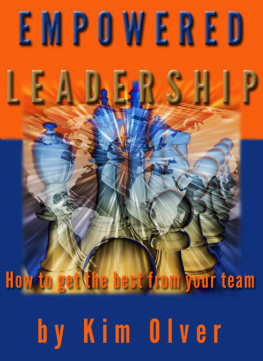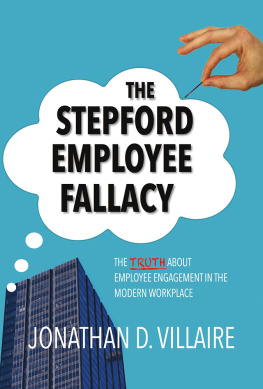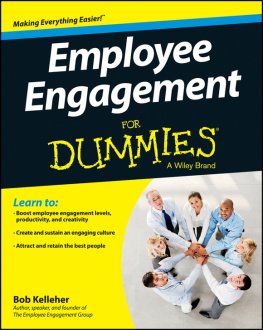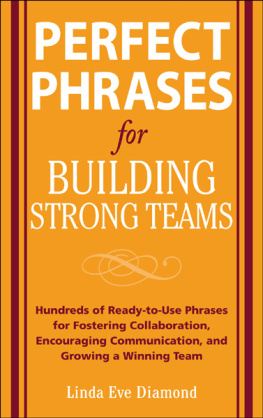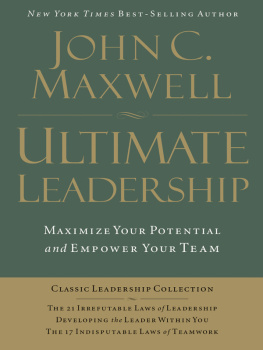Empowered Leadership
Copyright 2011 by Kim Olver
Smashwords Edition
InsideOut Press
Chicago, Illinois
Copyright Coaching for Excellence, LLC. All RightsReserved.
This eBook includes our Empowered LeadershipAction Book at the end of this eBook. Our action book containsall the worksheets necessary to complete each chapter. If you wishto have a printable workbook, a downloadable PDF of theEmpowered Leadership Action Book is available for purchaseat http://www.kimolver.com/actionbooks.php for only $1.99.
Table of Contents
Chapter 1: What is EmpoweredLeadership?
Chapter 2: Leadership Qualities
Chapter 3: Focus on the Product/Service
Chapter 4: Focus on the Producers
Chapter 5: The Coaching Model
Chapter 6: Time Management
Chapter 7: Valuing Diversity and Teamwork
Chapter 8: Conflict Resolution and Problem SolvingModels
Chapter 1: What is Empowered Leadership?
It seems that every decade or so there is some newfad the runs through the business world in terms of supervision,and in the current climate of diversity management, downsizing,outsourcing, generational work conflicts and the information age,things are even more complicated than ever before.
No longer does a one size fits all leadership modelreally work. We can't treat everyone the same and expect thateverything will just work out somehow. Managers and leaders musthave a framework with which to manage their workers in a way thathonors everyone's unique and specific position on the job. If youare a manager with the attitude that says, If you don't like it,there's the door. There's always someone waiting to take yourplace, you will not be successful with effectively managing theworkers of today.
Empowered Leadership provides managers withthe tools to be effective in today's work environment. Empoweredleadership teaches managers how to share the power with theirworkers, thus empowering both groups. By giving away some power,you will receive so much more in return through respect,cooperation and commitment. Do and of those sound like somethingyou would like more of?
Conventional wisdom tells us that when those in powerrelinquish some of that power by sharing it or giving it to theiremployees, then they would lose something when in actually, theygain.
Think about it. When people rule with an iron hand,they generally instill fear in those who work for them. Do you doyour best work when you are afraid? I don't know about you but Iwill attempt to comply because I want to avoid negativeconsequences but it certainly won't be my best work. The absolutebest a manager can hope for with coercion is compliance. Ifcompliance is enough, then coercion might work.
However, I will gripe and complain and quietly waitfor opportunities to get even. I won't have a kind thing to sayabout my employer and at every available chance will seekcorroboration for how I feel from my co-workers, thus spreading an"us" versus "them" mentality. In David Hawkins revolutionary book,Power versus Force, he talks about simple physics and reminds usthat anytime you use force to get someone to do something; you aremy scientific law creating and equal counterforce. It has to be. Itmay not be something that is readily apparent but it's therenonetheless. Is that something that will be conducive to qualitywork, commitment and respect to you? Probably not.
When leaders and managers seek to empower theirworkers, they will gain their loyalty. Workers want to give theirsupervisor their best when they are listened to and respected.Without fear, their minds can be creative and innovative.
When managers are willing to accommodate specialrequests and it doesn't interfere with product or service delivery,then their employees will be sure to give back their best inreturn. Giving away power only increases a manager's power.
Now, Empowered Leadership does not advocate that youbecome a total pushover and forget about producing your product orservice in favor of making things "nice" for your employees. As amanager, you have a two-fold job--you are to represent youremployees' desires, opinions and suggestions to management while atthe same time communicating management's issues, concerns andexpectations to your employees. This is not an easy line towalk.
You will never get the best from your employees ifthey don't respect you. You cannot be a doormat for your employeesto walk over. If they believe you have no bottom line ornonnegotiables, then they will never be satisfied and always askingfor more. You will feel used and abused and the truth is, you askedfor it.
As a manager, you must hold the bar high. Expectgreat things from each and every one of your workers. If you onlyexpect mediocrity, mediocrity is exactly what you will get. Set thestandards and lead by example. Ray Kroc, the founder of McDonald'ssaid, "The quality of a leader is reflected in the standards theyset for themselves." If your workers see you giving it your all, itwill be difficult for them to perform below standard.
You must have production goals you are attempting tomeet for either products or services. Always enlist the help ofyour employees to set the goals, with the underlying premise beingcontinual improvement.
And as a manager, you have the responsibility tocreate a need satisfying workplace for yourself and your workers.You cannot emphasize one to the exclusion of the other withoutthere being undesirable consequences.
When you focus on production only and forget thehuman capital, you will end up with resentful, resistant, angryworkers. On the other hand, when you only focus on the people endand allow production goals to be compromised; you will have workerswho do everything they can to take advantage and to get out ofdoing the work. After all, if you the manager don't valueproduction, why should they?
Somewhere in the middle, when you are successfullyand effectively walking that very fine line between relationshipsand production goals, you are practicing Empowered Leadership andthat's where you will get the most output from your employees interms of quality and quantity.
This concludes Chapter 1 of this eBook. In the nextchapter, we will discuss leadership qualities. Between now andthen, take the time to jot down your ideas about what constitutesan exceptional manager or leader on the worksheet provided in youraction book. It may be easier for you to talk about the absence ofsome negative qualities, as well as the possession of the positiveones. Complete the Chapter 1 worksheet in the EmpoweredLeadership Action Book to the best of your ability.
Chapter 2: Leadership Qualities
If you were asked to make a list of the qualities andcharacteristics of your best boss ever and then a separate list foryour worst boss' qualities and characteristics, I would wager itwouldn't be a difficult activity.
It is relatively easy to point out the qualities wehave appreciated in our supervisors and sometimes even easier toenumerate the qualities we didn't like in other supervisors. Thisis an activity I request participants to do in my EmpoweredLeadership workshop and the lists end up looking remarkablysimilar. They generally look something like this:
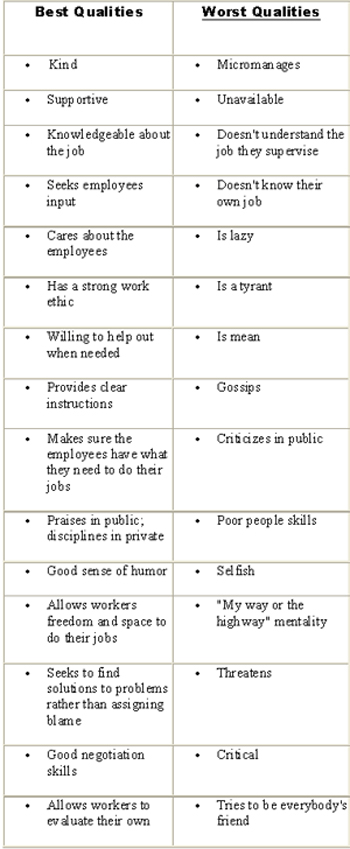
The Leadership Continuum
The characteristics listed on the left-hand side ofthe chart are the characteristics of an Empowered Leader.The ones on the right are not. Leadership styles are typicallyrepresented along a continuum with the optimal leadership stylebeing in the center of the continuum. At one end lies yourautocratic or authoritarian manager, while at the other end is yourlaissez-faire or free reign manager. The position in the middle hasbeen called a lead manager, a democratic manager, and aparticipative manager. In my model, the middle position is theEmpowered Leader.

